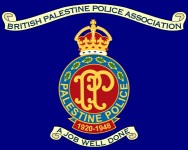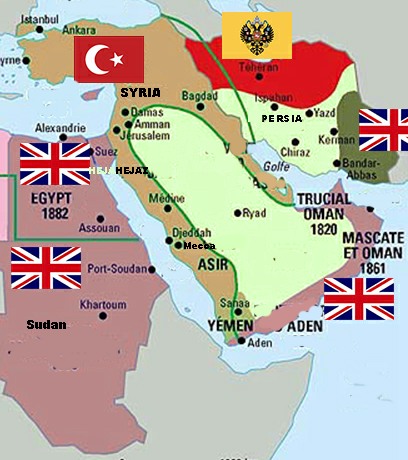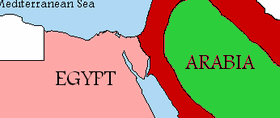Pages in Section 1

Situation in Levant prior to World War 1
ii. Situation Prior to August 1914
iii. WW 1 Protecting the Suez Canal
iv. WW 1 Promise 1
v. WW 1 Promise 2
vi WW 1 Promise 3
vii. WW1 The Conquest of Palestine
viii. O.E.T.A.
ix. 1919 Paris Peace Conference
x. Nebi Mussa Riots
xi. The Heroification of Trumpeldor
xii. St Remo Conference
 Beige indicates the area left in the Ottoman Empire at the beginning of 1914.
Beige indicates the area left in the Ottoman Empire at the beginning of 1914.
Red shows area of Imperial Russian influence.
Cream shows the independent area of Saudi Arabia.
Pink shows area under British control.
(Egypt,theoretically in the Ottoman Empire, was, in practice, ruled by the British.)
Cream shows the independent area of Saudi Arabia.
Europeans regarded the Ottomans as useful trading partners. The Ottoman government employed European technical advisers - French for its finances, British for its navy, German for its army and the Hejaz railway.
French Influence
France and the Ottoman Empire had been allies since the 16th century. France valued the alliance because of their mutual enemy, the Habsburgs of Austria. France justified her close alliance with a Muslim country to other Christian countries by saying she used her influence to protect Christians in the Middle East. Mainly due to France,the Ottoman Sultan allowed Christian pilgrims to visit Holy Places in Palestine and allowed Catholic monks and French missionaries to set up schools and hospitals in many parts of the Ottoman empire. He even allowed Christians to erect churches in Jerusalem and the port cities. Ancient privileges promised to the French by the Sultan back in the 17th century (known as the 'Capitulations')allowed the French many rights, especially immunity to local law, which the French exploited far beyond the original trading purposes of the concessions. Beirut and Jerusalem were centres of French culture, with Catholic schools teaching many thousands of pupils. French capitalists financed railways, ports, banks, mines and factories in the Levant. By 1914, 45% of the total foreign investment in the Ottoman Empire came from France.
British Influence
 The Sinai desert was now part of Egypt. In 1906, concerned about the proximity of the Ottoman Empire to the Suez canal, the British had persuaded the Turkish Sultan that the boundary between the sanjak (province) of Jerusalem and Egypt ran from Rafah to Aqaba. Previously the Ottoman government had claimed the southern border of the Jerusalem sanjak stretched from Rafah to Suez but they could not find the maps that substantiated that claim.
The Sinai desert was now part of Egypt. In 1906, concerned about the proximity of the Ottoman Empire to the Suez canal, the British had persuaded the Turkish Sultan that the boundary between the sanjak (province) of Jerusalem and Egypt ran from Rafah to Aqaba. Previously the Ottoman government had claimed the southern border of the Jerusalem sanjak stretched from Rafah to Suez but they could not find the maps that substantiated that claim.
By 1914, Winston Churchill, First Lord of the British Admiralty, had decided to use oil as fuel for the British Navy, and planned to build an oil pipeline from Iraq to the Mediterranean. To that end the British government had acquired a controlling interest in The Anglo-Persian Oil Company (APOC) which in turn had a 50% share in the Turkish Petroleum Company (TPC, created to develop oil resources in the Ottoman Empire.
Arab Nationalism in the Ottoman Empire
Unlike the independent central area of Saudi Arabia, the western region of Arabia (The Hejaz) was part of the Ottoman Empire and contained the Muslim holy cities of Mecca and Medina. Power in the Hejaz was shared by the Hashemite Sharif of Mecca,Ali ben Hussain, and the Ottoman regional governor, who was responsible for ensuring Ottoman sovereignty. Sharif Hussain believed that,as Sharif of Mecca and a descendent of the prophet Muhammad(p.b.u.h), he rather than the Ottoman Caliph was the rightful Sunni Caliph. To gain his rightful inheritance Sharif Hussain had begun discussions with local tribal leaders , Arab nationalists, and the British High Commissioner in Egypt, Sir Henry McMahon.
In Syria intellectuals, many of them graduates of Western universities, wanted the school syllabus, in the region which encompassed most of Palestine, to include Arab history, literature, and language. They formed secret groups aiming at Arab independence. Prince Faisal, son of the Sharif of Mecca, was a member of the major secret group, Al Fatat (the Young Arab Society).
Sephardic Jews of the Ottoman Empire
They regarded themselves as Ottoman citizens on a par with Christian Arabs. In Palestine they speak Arabic and wear the same clothes as Arabs. They mingle with Muslims and Christians in coffee houses.
Zionists in the Ottoman Empire
An organisation for helping illegal Zionist immigrants enter Biblical lands (Eretz Israel) owned by Turkey had existed for almost forty years. Despite Christian Russia being a long time enemy of Islamic Turkey, or perhaps because of it, the first Jewish illegal immigrants into Eretz Israel were mostly Russians and Eastern Europeans escaping pogroms. They had already set up several agricultural colonies both in Southern Syria (of which Northern Palestine was a part and in the sanjak of Jerusalem. There they faced considerable hostility, mainly from Christian Arabs who were pressing for an independent secular Arab state in Palestine. An incident occurred outside Rehovot in 1913 which kick-started the conflict between Arabs and Jews during the Post WW1 British Mandate. See the balanced film of the incident that kick-started the Israeli/Arab conflict "Seeds of Conflict" on YouTube or on CD